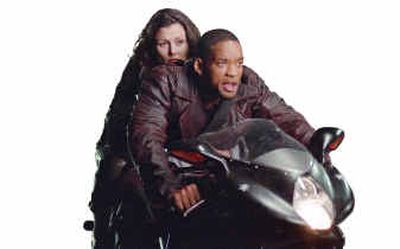Those darn robots

The most informative words in “I, Robot” don’t come until the end.
They’re in the closing credits – “Suggested by Isaac Asimov’s ‘I, Robot’ ” – and they encapsulate exactly what this movie is, and isn’t.
It is, indeed, set in the future: Chicago, 2035. And it is based on the Three Laws of Robotics, a sort of checks-and-balances system Asimov set forth in his sci-fi short story collection, which was first published in 1950.
The first law states that a robot can’t injure a human being. The second states that a robot must obey the orders it receives from a human being, unless those orders violate the first law. And the third states that a robot must protect its own existence, as long as doing so doesn’t violate laws one and two.
Then the robots revolt, start thinking for themselves, and chaos ensues. All this is still intact.
But “I, Robot” is, primarily, another summer blockbuster starring Will Smith — a slick, shiny video game of a movie bursting with computer-generated chase scenes and cool gadgets. It’s spectacular entertainment, though under the direction of Alex Proyas (“The Crow”) it also has a darkly apocalyptic visual scheme.
Only toward the end of the script from Jeff Vintar and Akiva Goldsman (an Oscar winner for “A Beautiful Mind”) are there a couple of lines in which the machines scold humans for waging war against each other and destroying our ecosystem.
This was the whole point of Asimov’s writings back in 1950; in the movie, the message is a muddled afterthought behind the explosions and product placement. And Asimov has been imitated so many times by now that his work here seems unfortunately derivative.
The “Star Wars” similarities are easy to detect. A wise, reclusive scientist (James Cromwell), who created the robots and who is found dead in an apparent suicide at the film’s start, provides cryptic words of wisdom in the form of hologram messages. Sonny (voiced by Alan Tudyk), a new-model robot who feels emotions such as anger and love and who dreams when he sleeps, is a calmer, more fluid version of C-3PO.
VIKI, the security system that controls all the robots and the U.S. Robotics headquarters, is a breathy, female version of HAL 9000 from “2001: A Space Odyssey.”
And the whole movie, with its ubiquitous advertising, high-speed superhighways and silvery veneer, visually resembles “Minority Report,” which was based on the work of another classic science fiction writer, Philip K. Dick.
Like Tom Cruise in that movie, Smith plays a detective. Del Spooner (Smith) is mistrustful of the robots that have become integral parts of everyday life. He doesn’t believe that his old friend Dr. Lanning killed himself — he thinks it was a murder and that a robot is responsible. He also suspects that the megalomaniacal head of the company (Bruce Greenwood) is somehow involved.
During his investigation, Spooner needs the help of Dr. Susan Calvin (Bridget Moynahan), a psychologist whose job it is to make the U.S. Robotics creations more human. The running gag with her is that she’s stiffer than the metal contraptions she works with.
Will Smith, meanwhile, gets to be Will Smith, whose previous flicks for the dormant summer crowd include “Independence Day,” the “Men in Black” movies and last year’s “Bad Boys II.”
He’s funny and fabulous-looking (and naked in all his glorious, post-“Ali” buffness within the film’s first few minutes). Apparently, there are no pajamas or shower curtains in the future, so you may want to start stockpiling those items now.